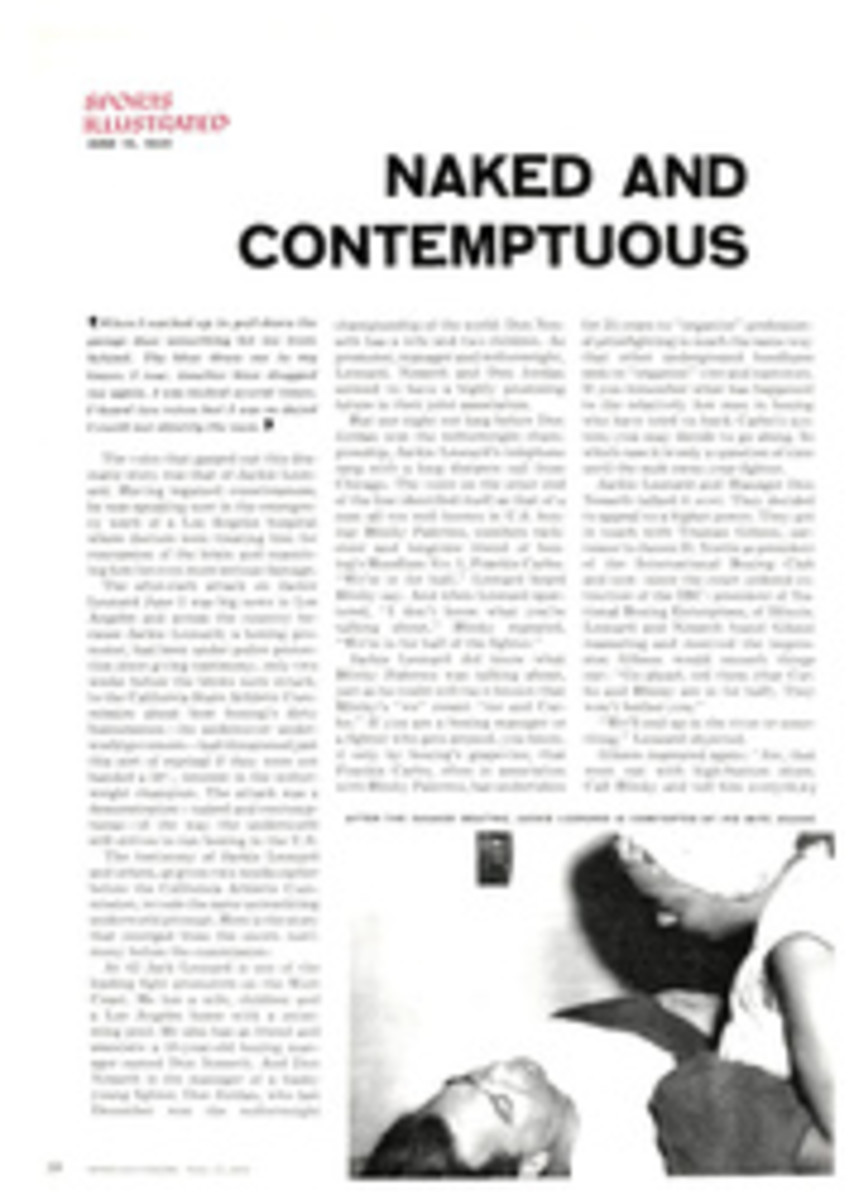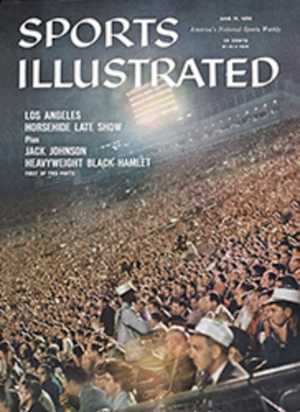
THE FLUSHING SPANIELS
Most hunters whohave ever owned a gun dog agree that with few exceptions these dogs also makefine house pets. More surprising, perhaps, is the fact that many house petsmake excellent gun dogs without losing any of the qualities which endear themto the family at home. Cocker and springer spaniels are particularly adaptableto the dual role of hunting and home companions. They are easy to teach, eagerto learn and generally enthusiastic by nature. Given proper training, almostany spaniel can fulfill both roles and add immeasurably to his master'senjoyment. He should, of course, first learn the simple rules of living withpeople. When he has mastered the commands to sit, to stay, to come when called('How to Educate the New Family Dog,' SI, July 14 & 21, 1958) he is readyto take to the field. For most spaniels, the right age will be between 6 and 9months. Up to a year and a half, the average dog can still be taught to hunt,but much beyond this age training may be more difficult. Regardless of whenfield training begins, however, it is important to remember that dogs, likepeople, are individuals; some learn more quickly than others.
Stanley MacQueen(above) is the first of four experts who, starting with this issue andcontinuing through the summer, will teach you how to field-train your sportingdog. Stanley, the third generation of MacQueens to take up gun-dog training,has spent the major part of his 29 years working with flushing spaniels. Thisinterest began in childhood under the guidance of his famous father, theinternational spaniel authority Larry MacQueen. Today father and son togethertrain and handle more than 100 spaniels every year at their Ramornie Kennels inPottersville, N.J. In the ultimate test of gun-dog training, the MacQueens havebeen represented at every national spaniel field-trial run in this country, andthey have won national championships three times.
First time in thefield
The opening phaseof field training is easy and very informal. It involves no more than takingthe young dog out in the field as often as possible to acquaint him with alltypes of terrain and game cover. A spaniel is born with a natural desire tohunt. Your job is to encourage this birdiness, as it is called, by making hisoutdoor sessions fun. Keep them short—a half hour every day rather than severalconsecutive hours once a week—and stop them, for a few days if necessary, whenthe dog seems to be tired or losing interest. The basic equipment you will needis a collar and lead, a whistle (police variety: 25¢), and a .22-caliber blanktraining pistol ($7.50). Always take the dog afield on the lead, and beforereleasing him make him sit, so he understands you are the boss. Let him runfree for a few minutes while he works off excess energy, then walk along in thedirection he takes. When he gets too far ahead of you, call him back. Each timeyou call him, follow the command with several short whistle blasts. Eventuallyhe will learn to associate this whistle signal with the voice command"Come." If he is slow at first, be patient, and avoid excessivecorrection. It is more important now that he develops interest in a variety ofcover than that he obeys every command. If he is reluctant to enter heavy brushor briers, encourage him by going in first. When you come to water, let himsplash and play in it. After the dog has been afield several times, accustomhim to the sound of gunfire by shooting the training pistol in the air. Makesure he is at least 100 yards away from you the first few times you fire sothat you don't startle him. Gradually decrease the distance as he becomes usedto the noise. When you are ready to leave the field for home, reward the pupwith stroking and praise as you put him back on the lead. Remember that themost important part of this early training is to make it fun for the dog. Itwill be if every session afield is relaxed and short.
Training pistolaccustoms pup to gunfire in the field.
Short runsacquaint puppy with thickets and brush.
Praise is thebest reward at end of session afield.
Shallow pond forsplashing introduce young dog to water.
First encounterwith birds
As soon as thepup is ranging freely, sniffing eagerly for signs of game, and entering allkinds of cover with boldness, he is ready for his first encounter with birds.At this stage it is not important that they be pheasants or grouse; pigeons arecheaper (they average 50¢) and easier to handle. Clip the flight feathers fromone wing to prevent the bird from flying. Hold the pigeon in your hand, and letthe dog sniff and nuzzle it. Then shake it slightly—this won't hurt the birdbut will dizzy it so it stays in one spot—and throw it a few feet from you.Encourage the dog to go after the pigeon by moving your arm toward it andsaying "Fetch." He will probably pick it up right away but he maydecide to play with it. It is better to let him do so briefly the first fewtimes than risk souring him on birds by correcting him. As soon as he takes thebird in his mouth whistle him to you. If he returns without the bird, repeat"Fetch" and encourage him by whistle and voice to bring it. When hedoes, reward him. Repeat this exercise daily, planting the bird farther awayeach time. And remember, be patient with his mistakes and generous withpraise.
Let puppy sniffthe bird to acquaint him with game scent.
Encourage dog tofind bird and bring it back to you.
First elements ofcontrol
After the dog hassome field experience behind him and is used to retrieving live birds, he isready for the basic exercises which will control him when hunting. Hand andwhistle commands are the tools with which you exercise control. The whistle isactually a substitute for the voice commands he has learned at home; in thefield it is more valuable than the voice because it carries farther and withmore authority. The dog already knows that a series of short blasts means"Come." The next and more formal whistle command is the sit-stay. Beginwith the voice command "Sit-stay." Follow it immediately with a single,sharp whistle blast, and reinforce it by holding your hand, palm toward thedog, as shown at left. Then move slowly away, steadying him with your hand andrepeating the single whistle blast if he tries to follow you. Once he mastersthis command—and it may require weeks of training—he will stop and sit to thewhistle whenever he hears it.
Control beginswith single whistle blast meaning "Sit."
Command isreinforced by hand and voice signals.
Responding tofield directions
A flushing dogmust stay within range of the gun (not more than 40 to 50 yards from you) andhunt all cover around you. On the previous page you learned how to stop him bywhistle anywhere in the field. The next step is to send, or cast, him off tohunt in another direction. Begin with the dog in sit position. Send him to theleft or right by moving your arm and body in that direction. Accompany the armsignal with two short whistle blasts. The double whistle blast is used to sendthe dog in any direction; the arm signal indicates the direction he is to go.As the dog ranges ahead of you, whistle him to stop. Then, with your arm andwhistle, cast him in a new direction. Repeat the signals daily until heunderstands them. When he does, you will be able to control the distance heranges and the area he hunts.
Trainer casts dogto the right with arm motion.
Outward movementof hand sends dog ahead.
Arm signalsdirect puppy; whistle sends him to hunt.
Responding toflushed birds
When you haveacquired control of the way your dog ranges in the field—this takes two tothree months of daily training—he is ready for the final exercise before anactual hunt: response to a flushed bird. This is called steadying the dog towing and shot. Use a scented dummy ($1.98) instead of a bird for this training.At first, the dog will be easier to handle on a check rope. Holding the ropeloosely, whistle the dog to sit. Throw the dummy in front of him and fire thetraining pistol. If he starts after the dummy, repeat the single whistle blastand pull sharply on the rope. The dog should remain steady until you give thesignal to retrieve. Repeat the exercise, gradually moving farther away from thedog. Each time, throw the dummy closer to him. This will tempt the spaniel tobreak. If he does, correct him immediately. Remove the rope only when he issteady. This is one of the difficult exercises to teach, but when the doglearns it, he is ready to go hunting.
The dog mustretrieve only upon command.
Check ropeprevents dog from breaking.
Throw dummy closeto dog to simulate a flushed bird.
Check rope islooped loosely at dog's neck.
Ready for thehunt
The most fun andthe most interesting part of training a spaniel for the field begins when youtake him out after live game. It can also be a trying time for the novicetrainer because his dog must face a number of new experiences. This will be theyoung spaniel's first encounter with birds that fly, with the louder noise of ashotgun instead of a training pistol, and with having birds shot over him. Youcan make it easier for the dog, and give yourself more freedom to control him,if you take along a friend to do the shooting. A .410 shotgun on the first fewhunts will also be less startling than a bigger, noisier gun like a 12-gauge.Pigeons are still the least expensive birds to use during these first shootingsessions. Before taking the dog into the field, dizzy several pigeons and plantthem at intervals in the cover. Then with your friend walking slightly apartand abreast of you, start the dog hunting. You will have greater control overhim if you limit his range to a maximum of 30 yards at first. Be on the alertat all times for signs of game. As soon as the dog flushes a bird, whistle himto sit. This is called hupping to the game. Although he should automatically dothis now, he may forget at the sight of a flushed bird. Anticipate such amistake by using the whistle command as often as necessary. The dog shouldremain steady in the hup position while your friend shoots the bird. Then sendhim after it. When the dog has had some experience on pigeons, take him to anatural game area or shooting preserve to acquaint him with pheasants. Anddon't expect even the brightest dog to be an expert right away. He will becomeone only with practice.
Teaching controlis easier if a friend does shooting.
Dog should sit or"hup" as soon as bird flushes.
Spaniel mustremain steady while hunter shoots the bird.
High point of thehunt
The reward ofthese training sessions afield and the high point of the hunt will come whenyour spaniel retrieves his first wild bird and brings it triumphantly to you.This is the climax of the months you have worked with him in the field, and itis also the moment when a sportsman realizes that, besides a pet, he owns auseful and intelligent gun dog. When you whistle him back after the bird hasbeen downed, remember that the dog will expect and deserve some praise fromyou. Give it to him enthusiastically, because now he is a hunter and has earnedit.
TRAILING HOUNDS
Part II of this series on field dog training willappear in an early issue. In it, Fred Huyler draws on his 70 years' experienceto tell you how to train trailing hounds.
TWENTY ILLUSTRATIONS
SHELDON FINK

